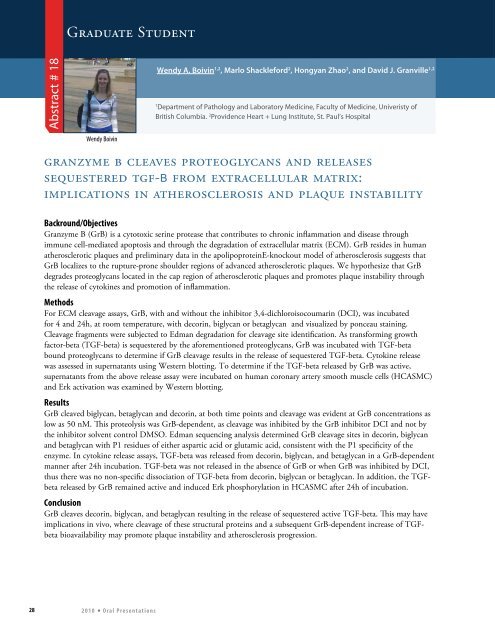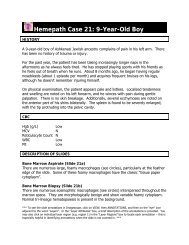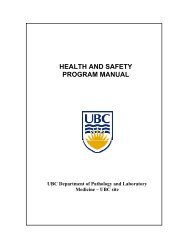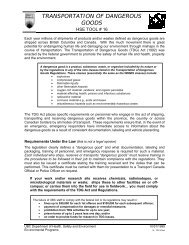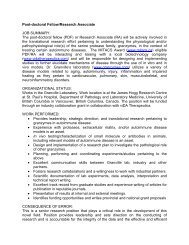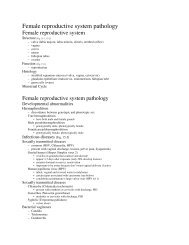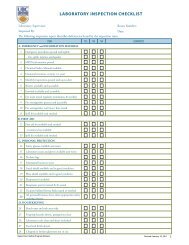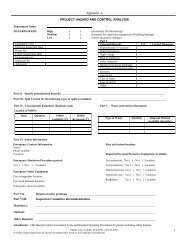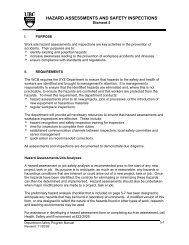Oral Presentations - Pathology and Laboratory Medicine - University ...
Oral Presentations - Pathology and Laboratory Medicine - University ...
Oral Presentations - Pathology and Laboratory Medicine - University ...
Create successful ePaper yourself
Turn your PDF publications into a flip-book with our unique Google optimized e-Paper software.
Graduate StudentAbstract # 18Wendy A. Boivin 1,2 , Marlo Shackleford 2 , Hongyan Zhao 2 , <strong>and</strong> David J. Granville 1,21Department of <strong>Pathology</strong> <strong>and</strong> <strong>Laboratory</strong> <strong>Medicine</strong>, Faculty of <strong>Medicine</strong>, Univeristy ofBritish Columbia. 2 Providence Heart + Lung Institute, St. Paul’s HospitalWendy Boivingranzyme b cleaves proteoglycans <strong>and</strong> releasessequestered tgf-β from extracellular matrix:implications in atherosclerosis <strong>and</strong> plaque instabilityBackround/ObjectivesGranzyme B (GrB) is a cytotoxic serine protease that contributes to chronic inflammation <strong>and</strong> disease throughimmune cell-mediated apoptosis <strong>and</strong> through the degradation of extracellular matrix (ECM). GrB resides in humanatherosclerotic plaques <strong>and</strong> preliminary data in the apolipoproteinE-knockout model of atherosclerosis suggests thatGrB localizes to the rupture-prone shoulder regions of advanced atherosclerotic plaques. We hypothesize that GrBdegrades proteoglycans located in the cap region of atherosclerotic plaques <strong>and</strong> promotes plaque instability throughthe release of cytokines <strong>and</strong> promotion of inflammation.MethodsFor ECM cleavage assays, GrB, with <strong>and</strong> without the inhibitor 3,4-dichloroisocoumarin (DCI), was incubatedfor 4 <strong>and</strong> 24h, at room temperature, with decorin, biglycan or betaglycan <strong>and</strong> visualized by ponceau staining.Cleavage fragments were subjected to Edman degradation for cleavage site identification. As transforming growthfactor-beta (TGF-beta) is sequestered by the aforementioned proteoglycans, GrB was incubated with TGF-betabound proteoglycans to determine if GrB cleavage results in the release of sequestered TGF-beta. Cytokine releasewas assessed in supernatants using Western blotting. To determine if the TGF-beta released by GrB was active,supernatants from the above release assay were incubated on human coronary artery smooth muscle cells (HCASMC)<strong>and</strong> Erk activation was examined by Western blotting.ResultsGrB cleaved biglycan, betaglycan <strong>and</strong> decorin, at both time points <strong>and</strong> cleavage was evident at GrB concentrations aslow as 50 nM. This proteolysis was GrB-dependent, as cleavage was inhibited by the GrB inhibitor DCI <strong>and</strong> not bythe inhibitor solvent control DMSO. Edman sequencing analysis determined GrB cleavage sites in decorin, biglycan<strong>and</strong> betaglycan with P1 residues of either aspartic acid or glutamic acid, consistent with the P1 specificity of theenzyme. In cytokine release assays, TGF-beta was released from decorin, biglycan, <strong>and</strong> betaglycan in a GrB-dependentmanner after 24h incubation. TGF-beta was not released in the absence of GrB or when GrB was inhibited by DCI,thus there was no non-specific dissociation of TGF-beta from decorin, biglycan or betaglycan. In addition, the TGFbetareleased by GrB remained active <strong>and</strong> induced Erk phosphorylation in HCASMC after 24h of incubation.ConclusionGrB cleaves decorin, biglycan, <strong>and</strong> betaglycan resulting in the release of sequestered active TGF-beta. This may haveimplications in vivo, where cleavage of these structural proteins <strong>and</strong> a subsequent GrB-dependent increase of TGFbetabioavailability may promote plaque instability <strong>and</strong> atherosclerosis progression.28 2 0 1 0 * O r a l P r e s e n t a t i o n s


